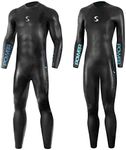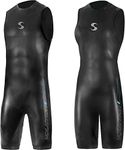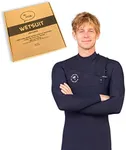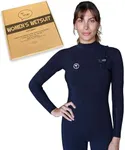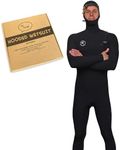Buying Guide for the Best Triathlon Wetsuits
Choosing the right triathlon wetsuit is crucial for your performance and comfort during the swim portion of a triathlon. A good wetsuit can provide buoyancy, warmth, and flexibility, helping you to swim faster and more efficiently. When selecting a wetsuit, consider the following key specifications to ensure you find the best fit for your needs.MaterialTriathlon wetsuits are typically made from neoprene, which provides insulation and buoyancy. The thickness and quality of the neoprene can vary, affecting flexibility and warmth. Higher quality neoprene is more flexible and comfortable, while thicker neoprene offers better insulation. Choose a wetsuit with the right balance of flexibility and warmth based on the water temperature and your swimming style.
ThicknessWetsuit thickness is measured in millimeters and usually ranges from 1mm to 5mm. Thicker wetsuits provide more warmth and buoyancy but can be less flexible. Thinner wetsuits offer greater flexibility but less insulation. For colder water, opt for a thicker wetsuit (4-5mm), while for warmer water, a thinner wetsuit (1-3mm) will suffice. Consider the water temperature of your triathlon events to determine the appropriate thickness.
FitA proper fit is essential for comfort and performance. A wetsuit should be snug but not restrictive, allowing for a full range of motion. It should fit closely to your body without any gaps or loose areas. When trying on a wetsuit, ensure it fits well around the shoulders, chest, and hips. If possible, test the wetsuit in water to check for any discomfort or chafing. Choose a wetsuit that fits your body shape and size perfectly.
BuoyancyBuoyancy helps keep your body afloat, reducing drag and improving swim efficiency. Wetsuits with varying buoyancy levels are available, with some offering more buoyancy in the lower body to help maintain a streamlined position. If you struggle with body position in the water, a wetsuit with higher buoyancy in the legs can be beneficial. Consider your swimming technique and choose a wetsuit that provides the right amount of buoyancy for your needs.
FlexibilityFlexibility is crucial for unrestricted movement, especially in the shoulders and arms. Wetsuits with higher flexibility allow for a more natural swimming motion and reduce fatigue. Look for wetsuits with flexible panels or thinner neoprene in key areas like the shoulders and arms. If you prioritize speed and efficiency, choose a wetsuit with high flexibility to enhance your performance.
SeamsThe construction of the seams affects the durability and comfort of the wetsuit. Seams can be glued, stitched, or taped, with glued and taped seams providing better waterproofing and comfort. Flatlock stitching is durable but can allow water to seep in, while blind stitching is more waterproof. Choose a wetsuit with seams that offer the right balance of durability and comfort for your swimming conditions.
ZipperThe type and placement of the zipper can impact ease of use and comfort. Back zippers are common and easy to use, while chest zippers offer better flexibility and reduce water entry. Some wetsuits have breakaway zippers for quick removal during transitions. Consider your preference for ease of use and comfort when choosing a wetsuit with the right zipper type and placement.

